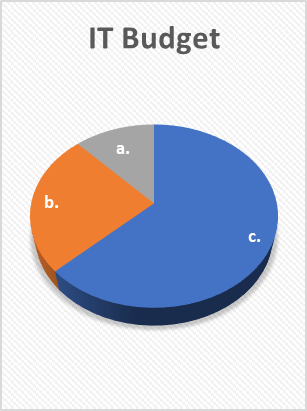IT reserves between data center and workstation

By far the largest proportion of the IT budget is usually held by IT operations: the costs of procurement, maintenance and operation of IT infrastructures and telecommunications are bound up in it, as are those of operation of applications, user support and the helpdesk/hotline, even through to IT security, failure safety and disaster recovery.
A large part of the spending is tied up over the long term in the area of IT operations. In many cases, outsourcing, licensing and maintenance contracts, service level agreements, etc. create fundamental changes in the cost structures through conversion of investments (CAPEX) into ongoing costs (OPEX).
Anticipated budget cuts when businesses start up again will force IT organizations to analyze their outgoings and cost structures from an overall perspective. In addition to a precise analysis of the various budget items – not least for IT operations – the services provided and the relevant performance indicators must also be checked.
IT budgets before and after the crisis
Irrespective of the CAPEX/OPEX distinctions, HR costs, etc., IT budgets can be broken down roughly into three categories:

- Category a.) VAS (Value Added Service) projects are often “additional” future and technology-oriented projects. VAS projects usually take up the smallest part of the IT budget.
- Category b.) Basic projects are maintenance projects in the widest sense, which maintain operations. They are very often complex migration and end-of-life projects with security issues, implementation of which is sometimes absolutely essential, but which do not offer the end user any additional features. Operation of further applications, automation, etc. falls into this category.
- Category c.) IT operations, i.e. provision, maintenance and operation of the IT environments. However well managed, IT operations usually consume well over 50% of the entire IT budget.
Users, on the other hand, usually want as high a proportion of the IT budget as possible for implementation of additional projects and services, i.e. VAS projects. The challenge: as categories b.) and c.) are usually fixed amounts, category a.), i.e. the “free” VAS projects, can be influenced most rapidly and flexibly.
However, this often means that new features, technologies and projects for further digitization are the first areas to give in to the crisis-related budgetary pressure. Holistic re-evaluations of cost structures on the part of the company and corresponding adjustments to the IT budget only increase this pressure.

To avoid getting “thrown under the bus”, ensure continued optimal use of IT resources and at the same time bring about the necessary cuts and re-allocation of resources, CIOs are therefore well advised to scrutinize all areas of IT, including supposedly fixed parts of the budget, in good time.
If they do not do so, many projects will be stopped (often with a scatter-gun approach for want of IT knowledge) and the proportion of operations costs in the IT budget will increase. In the worst case, only minimal funds will be left for important and/or future-oriented projects. The two main points of budget comparison before and after the crisis illustrate this problem.
The search for hidden treasure

Timely and rapid preparations can get IT fit enough to take on these challenges. CIOs are required to take appropriate measures and draw up scenarios!
ONE potential element among many for shifting resources is to reduce excessive demands on IT operations or, on the other side of the same coin, avoid over-commitments on the part of IT operations: in practical day-to-day operations, service levels are often over-ambitious, for example. In many cases, they are not even utilized, so critical scrutiny is certainly worthwhile!
ResultONE’s Act2Perform© procedural model supports CIOs on this path:
- In the collaborative approach of Act2Perform©, the company and ResultONE work together on scenarios to derive effective principles for decision-making and propose solutions in the form of measures to be taken.
- In the competitive approach of Double-Act2Perform©, the company andResultONE work out proposed solutions separately on the basis of defined scenarios. Only at the last stage of the model are the results brought together, evaluated and then agreed as a package of measures to be taken.